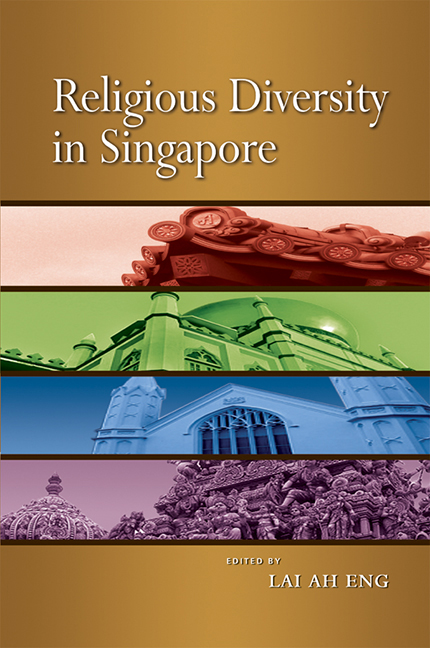Book contents
- Frontmatter
- Contents
- List of Figures and Tables
- List of Appendices
- FOREWORD
- PREFACE
- Acknowledgements
- The Contributors
- Abbreviations
- Glossary
- INTRODUCTION
- PART I The Landscape of Religious Diversity
- PART II Religion in Schools and Among the Young
- PART III Religion in the Media
- PART IV Religious Organizations in Social Services
- PART V Interfaith Issues and Interaction
- 23 Religious Diversity, Toleration and Interaction
- 24 Negotiating Christianity with Other Religions: The Views of Christian Clergymen in Singapore
- 25 The Inter-Religious Organization of Singapore
- 26 Interactions among Youth Leaders of Different Faiths: Realities from the Ground and Lessons Learnt
- 27 Building Bridges between Christians and Muslims: A Personal Journey
- 28 Conclusion: Some Remarks on Religious Diversity in Singapore
- Index
28 - Conclusion: Some Remarks on Religious Diversity in Singapore
from PART V - Interfaith Issues and Interaction
Published online by Cambridge University Press: 21 October 2015
- Frontmatter
- Contents
- List of Figures and Tables
- List of Appendices
- FOREWORD
- PREFACE
- Acknowledgements
- The Contributors
- Abbreviations
- Glossary
- INTRODUCTION
- PART I The Landscape of Religious Diversity
- PART II Religion in Schools and Among the Young
- PART III Religion in the Media
- PART IV Religious Organizations in Social Services
- PART V Interfaith Issues and Interaction
- 23 Religious Diversity, Toleration and Interaction
- 24 Negotiating Christianity with Other Religions: The Views of Christian Clergymen in Singapore
- 25 The Inter-Religious Organization of Singapore
- 26 Interactions among Youth Leaders of Different Faiths: Realities from the Ground and Lessons Learnt
- 27 Building Bridges between Christians and Muslims: A Personal Journey
- 28 Conclusion: Some Remarks on Religious Diversity in Singapore
- Index
Summary
The chapters in this book vary tremendously in focus and emphasis. At the same time, each chapter writer has identified some key trends and issues within his/her research topic as well as offered insights and drawn conclusions, and some have even made recommendations for policy and practice towards better inter-religious understanding and management. But even at a voluminous twenty-seven chapters, this book does not offer a comprehensive overview of religious diversity in Singapore as there remains huge and important gaps. As such, only some general remarks can be made here in place of firm conclusions or easily made motherhood statements about religious diversity and harmony.
First is that there are huge and important gaps in knowledge and understanding about Singapore's religious landscape which need to be filled. They include:
(1) the impact of globalization, development and modernity on religion and religious life in Singapore, including global and regional impulses and influences, and secular-religious distinctions and issues;
(2) various religions, movements, communities and groups, examples of which are Jainism, Chinese folk religions, “New Age” religions and new spiritual movements, “free thinkers”, immigrants, non-religionists and secularists, and histories of religious communities and their religious lives;
(3) religious trends, processes and issues, including proselytization, conversion and religious switching; religious syncretism and hybridization; everyday life religiosity; religious socialization in families, among youths and in schools and religious institutions; and religious representation in public and private spheres;
(4) gender and religion issues;
(5) state and religion, such as issues pertaining to the secular state-religious society relationship, and collaborations and collisions between state and religious organizations;
(6) interfaith issues and interactions in various domains, such as within families, schools, workplaces, neighbourhood localities and public spaces; by various agencies and actors such as organizations, leaders, colleagues, parents and students; local histories of inter-religious issues and interactions; and interfaith dialogue initiatives and challenges; and
(7) religious responses to specific political, economic, social, scientific and environmental issues.
That some of these gaps are not examined in this book is likely to lead to questions being raised about representation and representativeness.
- Type
- Chapter
- Information
- Religious Diversity in Singapore , pp. 689 - 694Publisher: ISEAS–Yusof Ishak InstitutePrint publication year: 2008



